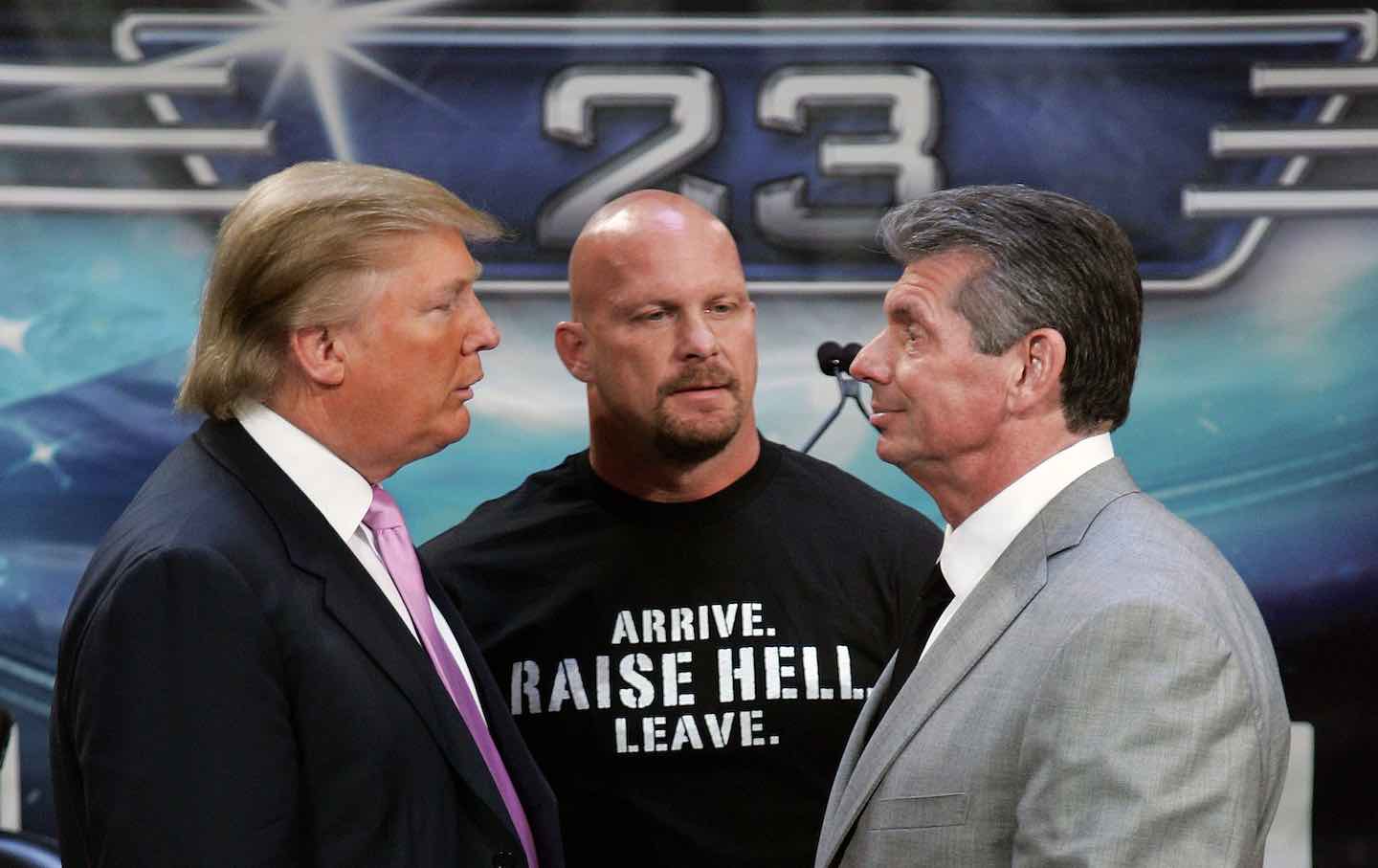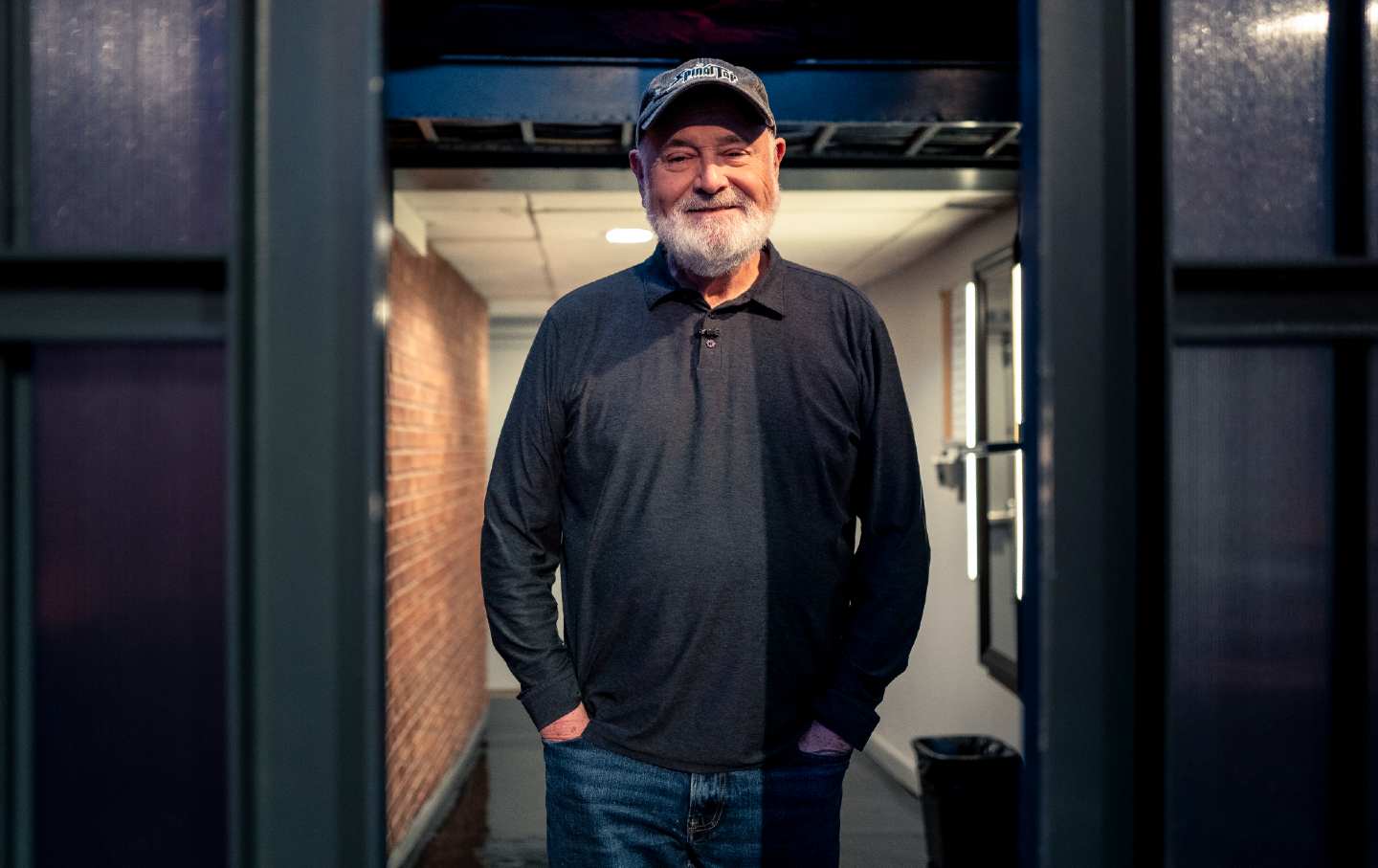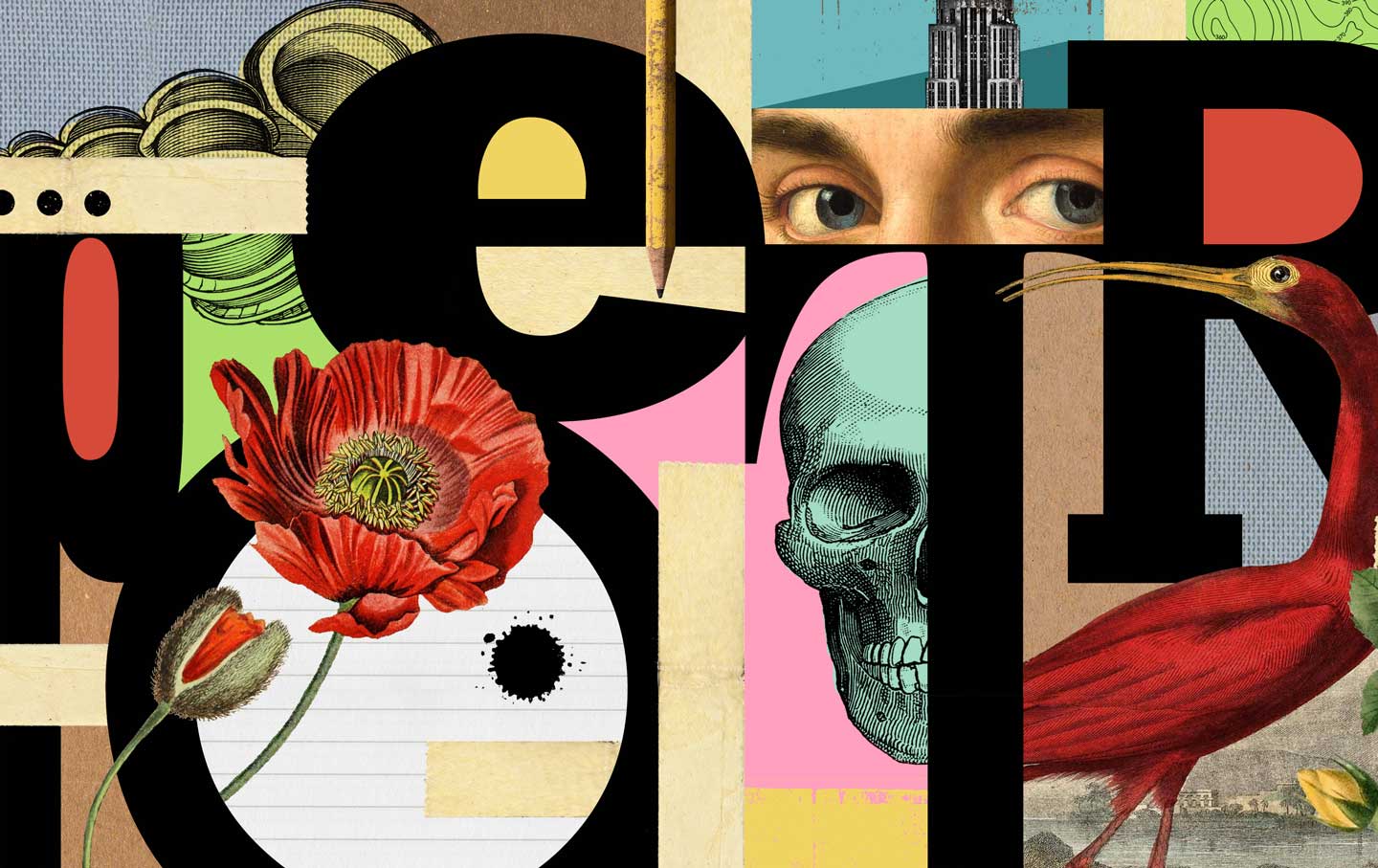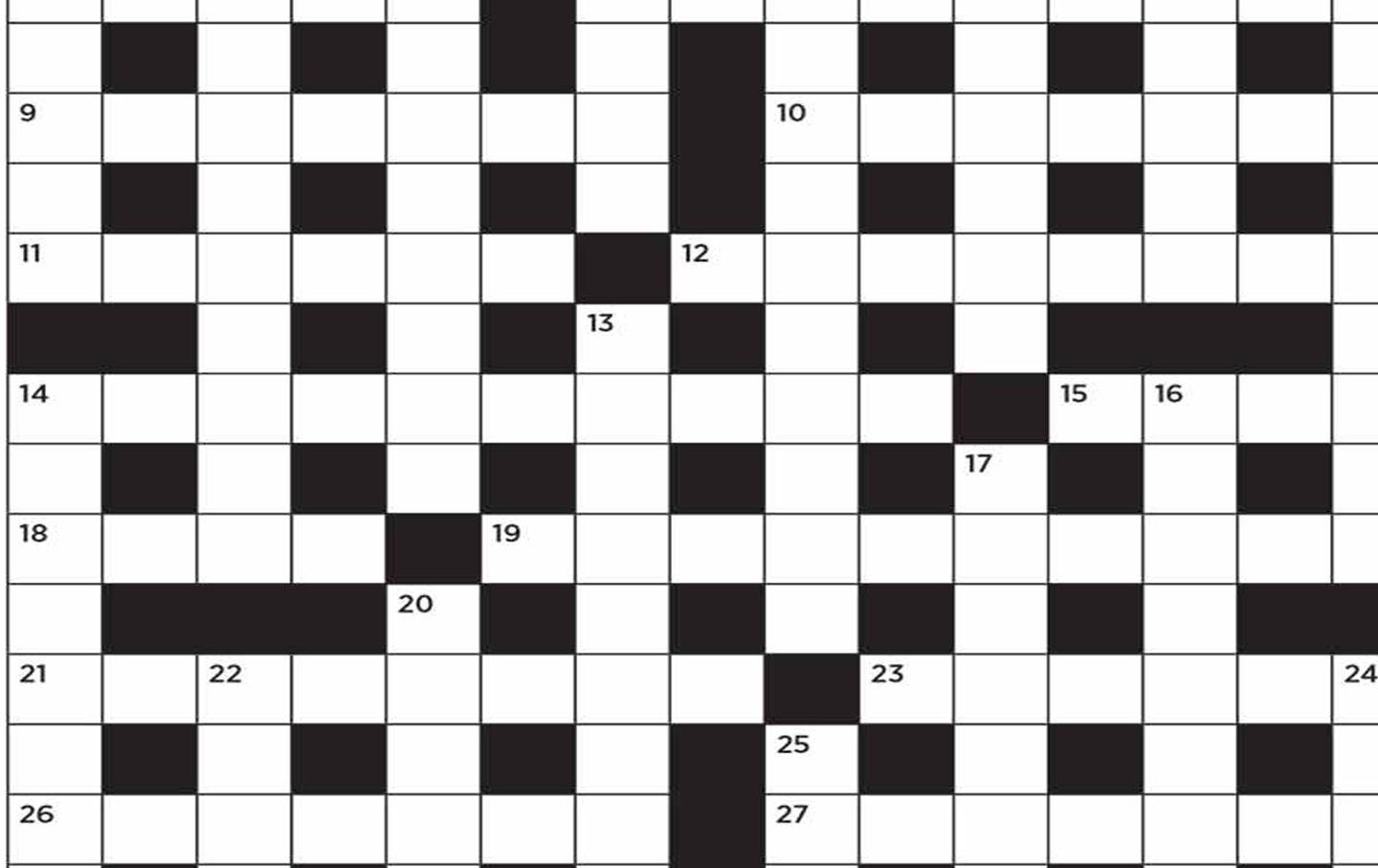The Misunderstood History of American Wrestling
A recent biography of WWE executive Vince McMahon presents him as an entertainment tycoon who changed culture and politics. The real story of his rise is as banal as it is brutal.

In the 1980s, as the company then known as the World Wrestling Federation reached new heights of national success, there was a brief surge in mainstream press coverage of professional wrestling. Pundits and reporters were understandably drawn in by the cartoonish spectacle, the synergetic crossover with mainstream celebrities like Mr. T and Cyndi Lauper at the first WrestleMania, and the mystery of a sports universe governed by arcane rituals, vaudevillian jargon, and shadowy business executives like Vince McMahon, a man who embodied wrestling’s contradictions—a slick corporate suit and a carny to the bone.
Books in review
Ringmaster: Vince McMahon and the Unmaking of America
Buy this bookThough the WWF had already begun its ascent to mainstream dominance with the help of the cable television boom, it had not yet solidified its stranglehold on American professional wrestling. By the early 2000s, McMahon was effectively the only major player left standing in what had once been a Mafia-style system of allied promoters maintaining regional fiefdoms. His company would rename itself World Wrestling Entertainment (WWE) after a successful trademark lawsuit by another WWF: the World Wildlife Fund. The WWE acronym has essentially become synonymous with professional wrestling in the mind of the American consumer, dominating not only the industry but also the slice of the cultural imagination that it occupies.
The story of American pro wrestling since at least 1980 is in many ways the story of Vince McMahon himself. In Ringmaster, a new biography of McMahon, the journalist Abraham Josephine Riesman charts his Citizen Kane–like journey from local wrestling promoter to robber baron, as he secured a near-monopoly of the American wrestling industry. Riesman’s thesis is that McMahon and the culture he produced is of a piece with the rightward lurch of American culture and the rise of one Donald Trump, a longtime associate of McMahon’s who has made cameos in his shows over the years. Yet one wonders if this gives McMahon too much credit.
Back in the 1980s, even as his stock was rising, McMahon was far from the only scummy boss in pro wrestling. Retired wrestler and former NFL lineman Jim Wilson saw the novel flurry of interest from wrestling outsiders as an opportunity to expose the sport’s dismal labor conditions: As he would later document in the 2003 book Chokehold: Pro Wrestling’s Real Mayhem Outside the Ring, Wilson was blacklisted from the industry after he began working toward the still-unrealized horizon of unionizing the locker room. At that time, the WWF was the clunkier WWWF, and its promoter was Vince’s father, Vincent James McMahon Sr., whose territory encompassed the Northeast; wrestlers to this day refer to going to WWE as working “New York” or “up North,” even as the company has expanded to become—literally—worldwide.
Jim Wilson never worked for either McMahon, but he was more than familiar with the shady tactics and exploitative practices carried out by the bosses of the National Wrestling Alliance (NWA), from stiffing wrestlers on their pay to blacklisting and sexual abuse. The elder McMahon was a central member of the NWA, an oligopoly of affiliated promoters that first solidified control over American wrestling and had long been the subject of antitrust suits. Wilson would make appearances on several media programs across the 1980s, hoping that publicly blowing the whistle on an industry that often operated without regulation or oversight would lead to some protection for wrestlers.
One program is remembered more than any of the rest, though not because of Wilson: A 1984 episode of 20/20 that cast its lens on the wrestling business quickly became infamous after wrestler David Schultz slapped host John Stossel, who had been asking prying questions to wrestlers at a show. Stossel made the mistake of stepping up to the redneck bruiser—who would become a professional bounty hunter after leaving wrestling—with the one question you never ask a wrestler: “I’ll ask the standard question, you know: I think this is fake.” Though the response to that question might be more layered and nuanced in 2023, at the time, the highest priority was protecting the business: If someone asserted that wrestling was fake, you had to prove that it was real, with brutal force.
The slap heard around the world overshadowed any real grievances that wrestlers like Jim Wilson might have shared in the episode, as Stossel hit the WWF with an injury lawsuit. Though Schultz was allegedly working on orders from McMahon to put Stossel in his place, the boss gave him up as a sacrificial lamb and fired him from the company. The incident is often recounted in wrestling histories as a formative moment in McMahon’s career, a shining example of not only his willingness to throw workers under the bus, but how easily he would change his tune; within the next few years, McMahon would state on the record, in court, that wrestling was not a legitimate athletic contest in order to escape the prying eyes of state regulators.
Wilson had been recruited to appear on 20/20 as one of the few workers willing to reveal the industry’s secrets. Another wrestler who was interviewed, Eddy Mansfield, publicly demonstrated one of wrestling’s most trusted but gruesome special effects: “blading,” the act of making a small incision on the top of your forehead with the tip of a razor blade in order to create the appearance of a bloodier injury than was actually received. It was the kind of showbiz arcana that made the spectacle so captivating to the uninitiated—like many aspects of wrestling, the practice of blading is banal for insiders but seems barbaric by most social mores.
In his book, Wilson writes about his time as a television talking head with marked disdain. While he hoped to build solidarity with wrestlers like Mansfield, Wilson found that his peers were hungry for media attention and had no abiding interest in improved labor conditions. His belief that outside scrutiny might push wrestling to evolve was similarly misplaced: Wilson soon realized that journalists like Stossel were more interested in exposing the tricks behind the spectacle than casting a light on worker exploitation. Riesman doesn’t recount the story of Wilson and his struggles against wrestling’s management class in Ringmaster, and that void clarifies what her book misses. Vince McMahon may want historians to remember him as a sui generis tycoon, perhaps even a sort of world-historical figure, but in reality he is something far more ordinary: a bad boss.
To be fair, as the tale spun by Riesman in Ringmaster shows, while the longtime WWE chairman may have taken the reins of his father’s company, he was more than your average “nepo baby.” Vincent Kennedy McMahon Jr. was born Vinnie Lupton, an average boy of somewhat hardscrabble origins in North Carolina. It was only after reuniting with his birth father as a teenager, and undergoing his tutelage in the mysterious ways of the wrestling business, that Vince took on the moniker that made him infamous.
Riesman has an interest in origin stories, having previously written True Believer, a biography of Marvel Comics kingpin Stan Lee, and in Ringmaster, she seems most intrigued by McMahon’s early years. As she notes in the acknowledgments, the book was largely a product of the early pandemic, and thus the only on-the-ground reporting she conducted was in McMahon’s childhood stomping grounds of Craven County, N.C. But little is revealed by the interview subjects she tracked down in his hometown—mainly childhood neighbors—who hadn’t thought about the former Vinnie Lupton in decades.
Popular
“swipe left below to view more authors”Swipe →Even after paying his dues as an on-screen announcer and backstage assistant, the younger McMahon wasn’t exactly handed the throne: He had to purchase the WWF from his father instead of inheriting it outright. Though he may have taken his father’s name, Vince Jr. didn’t have the same patience for the backroom gentlemen’s agreements of the NWA. Like the auto industry, old-school wrestling promoters believed in free market competition up to a point, working together to maintain their individual strongholds instead of putting each other out of business. Wrestling was regional in part because of the limits of local broadcast television, but the development of cable allowed for a wider reach than ever before, and it was only a matter of time before a promoter decided to go national. McMahon made the first definitive move by pushing his father to withdraw from the NWA in 1983, which freed him to broker deals with television networks across the country. One by one, the WWF would invade territories once unquestionably controlled by his father’s coconspirators until the competition had been put out of business for good.
The arc of McMahon’s ascendency in the 1980s and early ’90s—coinciding with a litany of scandals around steroids, sexual abuse, and the tragic early deaths of too many wrestlers—is covered in Ringmaster, with the narrative extracted in broad strokes from secondary and tertiary sources, such as Vice’s hit TV series Dark Side of the Ring and the work of established wrestling historians like Tim Hornbaker. A central text for Riesman is Mike Mooneyham and Shaun Assael’s Sex, Lies, and Headlocks, one of the first major investigations of McMahon and his company, published in 2002. But because of Riesman’s curious decision to end Ringmaster around the year 2001, the parameters of her story don’t go far beyond these citations.
The year that Ringmaster loses interest in wrestling is the year that Riesman herself lost interest as a fan, she tells us, after actively watching it from 1999 to 2001. Her curiosity about the form was reactivated in the early stretches of the lockdown. With that context in mind, it becomes clear that Riesman’s vantage point on professional wrestling is mainly from in front of a TV screen, interfacing with it only as an entertainment spectacle and not as a living, breathing medium that has evolved in places outside the reach of McMahon. That’s also the way that McMahon wants you to view it: as a manufactured “sports entertainment” product. Though Riesman promises a portrait of the real McMahon, beyond childhood anecdotes, most of her engagement with him is as a TV character.
The issue with Riesman’s lack of context for wrestling beyond WWE isn’t that she hasn’t seen the right matches or doesn’t know the right names to drop, but that her perspective here lacks the skepticism required of a devoted wrestling fan. It’s a sport that requires a barrel of salt more than a grain, as you’re forced to navigate contrasting stories and conflicting accounts meant to make one of the parties involved look better and another party worse. Even when someone claims to offer the cold, hard reality of wrestling, you should be wary of what you’re being sold. Wrestling is a welcome home to carnies and con artists, after all.
Thus, as much as Riesman’s book aims to critique McMahon, it gives us only a cursory glance at the past 20 years and therefore inadvertently reinforces the monopolistic notion that WWE will always be the center of the wrestling universe. This all-too-common misconception is the direct result of McMahon’s historical revisionism, which sells WWE as the be-all and end-all of professional wrestling: “Then, Now, Forever, Together,” as the company’s imperial motto puts it. In Riesman’s view, McMahon is just the natural conclusion of wrestling’s capitalist impulses, and there is no way to imagine what wrestling might be outside of his manufactured vision.
History has long been a crucial weapon in McMahon’s PR arsenal, as he asserts his dominance to silence refutative arguments, obscure past scandals, and denigrate his competitors. In the official WWE narrative, wrestling was a backward medium that lived in smoky bingo halls and church basements until Vince brought it into the 21st century. But nothing could be further from the truth: Wrestling’s reliable audience and cheap production costs made it a linchpin of early broadcast television, and old-school footage from historic venues like the Dallas Sportatorium shows a fervor among fans not unlike Beatlemania. WWE’s cultural grip is so tight that it obscures much of this vivid picture.
In reality, even McMahon’s monopoly functions as part of a larger internationalist paradigm, which goes mostly unacknowledged in Ringmaster. Of course, the “W” in “WWE” stands for “World,” and McMahon’s business has long had a strong global footprint—but since its inception, pro wrestling has been predicated on exchanges of talent and skills across cultures and national borders. The form has endless styles and variations, from Mexican lucha libre to Japanese puroresu. If Riesman is aware of the true diversity of wrestling and how fluid a medium it can be, she never lets us know, which casts suspicion on the assumptions that underpin the book: that professional wrestling is right-wing and inherently American.
There’s a parallel history of pro wrestling to be written, one that runs counter to some of Riesman’s claims. While the rest of America hardened itself to the world, American wrestling became even more open to it, as fans and wrestlers alike fed up with McMahon’s dominance increasingly looked beyond our borders for alternatives. All Elite Wrestling, the first major competitor to WWE’s monopoly in almost two decades, would likely not exist if not for the massive growth in Japanese wrestling’s American viewership since the 2010s, alongside the increased presence of women, queer talent, and people of color in both the locker room and the audience. Almost every week on cable, you can see wrestlers from around the world receiving sincere adoration from American audiences, as well as American wrestlers who have learned from their peers abroad and incorporated international styles into their own. American pro wrestling does still have its hints of jingoism—like the hideous American-flag neck tattoo of AEW cofounder and current WWE superstar Cody Rhodes—but even in the Trump era, it’s an industry that has taken increasingly centrist rather than hard-right positions, and fans more often than not cringe at nationalist or stereotypical imagery: The WWE, for example, now emphasizes its improvements in racial diversity and gender equity as a selling point.
More than a tacit business partnership, the perceived alliance between Trump and McMahon is its own kind of advertising, one that serves to make each man look more cunning than he actually is. With right-wing leeches like Sam Hyde finding a home in celebrity boxing, MMA constantly producing violent misogynists like Andrew Tate, and Trump himself frequently sitting front row at UFC events, Ringmaster’s preoccupation with the 45th president’s wrestling fandom might miss the way in which other combat sports have opened themselves up to reactionaries—Trump’s business associations with boxing promoters in Atlantic City run maybe even deeper than his occasional partnerships with McMahon. But it’s also a line of analysis that feels like recycled gimmickry: The relationship between McMahon and Trump, on-screen and off, was the subject of numerous essays during his administration, like Jeremy Gordon’s “Is Everything Wrestling?,” and full-length books like Lavie Margolin’s TrumpMania: Vince McMahon, WWE and the making of America’s 45th President.
Besides, you might not need pro wrestling to understand Trump at all: Real estate, the industry that produced him, is a scheme better than anything a wrestling promoter could ever cook up. In the larger context of wrestling history, Trump’s front-row fandom is not unique among powerful political figures. During the 1970s and ’80s, Jimmy Carter’s mother became something of a minor celebrity as a visible attendee of Atlanta-area wrestling shows, and the Georgia-born president was himself close friends with the masked legend Mr. Wrestling II.
Even if Jim Wilson’s message of making wrestling more humane fell on unwilling ears, his writing makes a vital case for taking wrestling seriously in spite of its rampant exploitation: Wrestling is work, and to dismiss it as anything less plays right into the hands of promoters and bosses, whose predatory existence subsists on the idea that because wrestling is seen as unserious and unreal, the work is therefore fake, when nothing could be more real. When you watch a match, you are never not reminded of the toll it takes, the physical exploitation and emotional injury it produces.
At its foundation, beneath the machinations of kayfabe and the secretive jargon that Ringmaster gets lost in, wrestling isn’t anything more complicated than two people standing on opposite sides of the ring; the rest is just marketing. To focus too much on a figure like McMahon, even if the purported aim is to criticize, obscures the material reality of wrestling, overlooking both the singular sacrifices of its workers and their creative contributions. Beneath all the pomp and circumstance, a wrestling promoter is like any old boss: Vince McMahon’s defining accomplishment is convincing us that we ever needed him.
Disobey authoritarians, support The Nation
Over the past year you’ve read Nation writers like Elie Mystal, Kaveh Akbar, John Nichols, Joan Walsh, Bryce Covert, Dave Zirin, Jeet Heer, Michael T. Klare, Katha Pollitt, Amy Littlefield, Gregg Gonsalves, and Sasha Abramsky take on the Trump family’s corruption, set the record straight about Robert F. Kennedy Jr.’s catastrophic Make America Healthy Again movement, survey the fallout and human cost of the DOGE wrecking ball, anticipate the Supreme Court’s dangerous antidemocratic rulings, and amplify successful tactics of resistance on the streets and in Congress.
We publish these stories because when members of our communities are being abducted, household debt is climbing, and AI data centers are causing water and electricity shortages, we have a duty as journalists to do all we can to inform the public.
In 2026, our aim is to do more than ever before—but we need your support to make that happen.
Through December 31, a generous donor will match all donations up to $75,000. That means that your contribution will be doubled, dollar for dollar. If we hit the full match, we’ll be starting 2026 with $150,000 to invest in the stories that impact real people’s lives—the kinds of stories that billionaire-owned, corporate-backed outlets aren’t covering.
With your support, our team will publish major stories that the president and his allies won’t want you to read. We’ll cover the emerging military-tech industrial complex and matters of war, peace, and surveillance, as well as the affordability crisis, hunger, housing, healthcare, the environment, attacks on reproductive rights, and much more. At the same time, we’ll imagine alternatives to Trumpian rule and uplift efforts to create a better world, here and now.
While your gift has twice the impact, I’m asking you to support The Nation with a donation today. You’ll empower the journalists, editors, and fact-checkers best equipped to hold this authoritarian administration to account.
I hope you won’t miss this moment—donate to The Nation today.
Onward,
Katrina vanden Heuvel
Editor and publisher, The Nation
More from The Nation

Why “The Voice of Hind Rajab” Will Break Your Heart Why “The Voice of Hind Rajab” Will Break Your Heart
A film dramatizing a rescue crew’s attempts to save the 5-year-old Gazan girl might be one of the most affecting movies of the year.

How Laura Poitras Finds the Truth How Laura Poitras Finds the Truth
The director has a knack for getting people to tell her things they've never told anyone else—including her latest subject, Seymour Hersh.

Rob Reiner’s Legacy Can't Be Sullied by Trump’s Shameful Attacks Rob Reiner’s Legacy Can't Be Sullied by Trump’s Shameful Attacks
The late actor and director leaves behind a roster of classic films—and a much safer and juster California.
Solution to the “Big Event” Crossword Solution to the “Big Event” Crossword
If questions remain after reading this, please write to sandy @ thenation.com.




